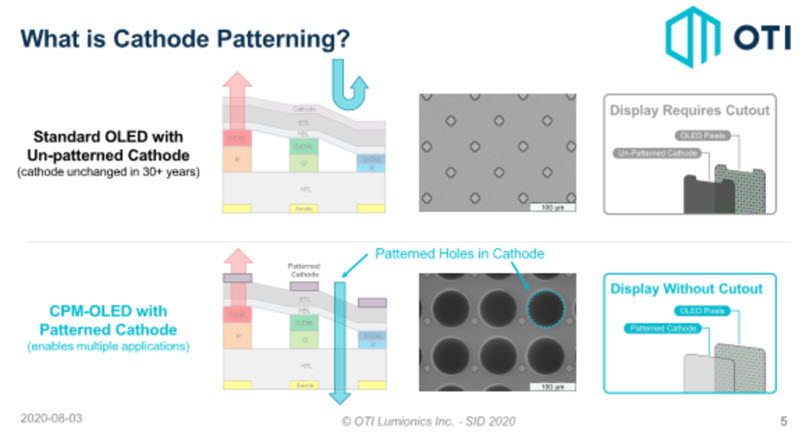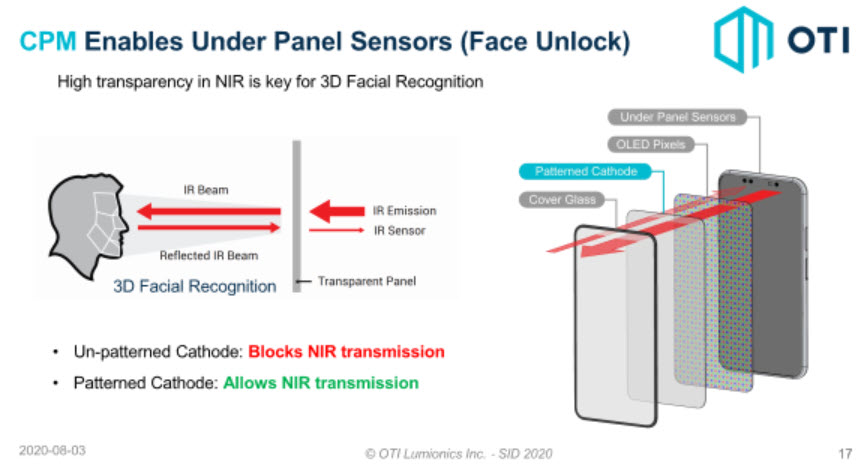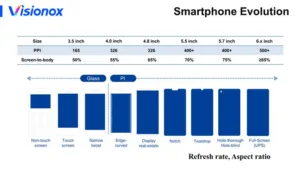I miss the talks that David Barnes used to give at the SID Business Conference, before he retired. He once described the LCD business as, from an economist’s point of view, looking like a material resale business that needed a shop costing several billion dollars. One of the structural changes that the Korean panel makers are trying to make is from a panel industry that is dominated by materials and their costs to one that is more dependent on processes and manufacturing technology. Still, materials remain important and can be innovative.

One of the big trends discussed at the recent DSCC/SID Business Conference was the trend to under display cameras. Dr Jianping Chen of Visionox showed the evolution of displays in smartphones.to take account of a desire to hide the camera.
However, there are challenges in creating displays that can work well in this application.
Michael Helander is CEO of OTI Lumionics of Toronto, Canada and he talked about cathode patterning materials (CPMs) for OLEDs. The company’s technology allows bigger panels and higher transparency in OLEDs using his firm’s new materials. As a start-up, the firm uses computational materials design to customise materials and innovate rapidly. For manufacture, the company works with established partners. Helander said that it uses Quantum Computing (or a quantum-inspired algorithm) for its development.
Helander explained why cathode patterning is important and what it is. He said that conventional cathodes cover the whole OLED material and uses thin metal layers and the layer has remained basically unchanged for 30+ years. However for some new applications, such as sensors behind the display, the metal can become a problem so notches may have to be cut or holes punched to allow light through. As an example, with CPMs, holes could be put in the cathode to improve the transparency and eliminate the need for a cut out.

Standard methods such as lithography, IJP, FMM or laser etching are not suitable for current OLEDs for technology or cost reasons. So how does OTI make the cathodes with regular holes? The answer is that the material uses self-assembly to create the cathode. It is compatible with all OLED stacks and can pattern from ?m to cm scale features (on the same substrate).
First the CPM material is deposited using FMM to establish a pattern, then the metal is deposited with an open mask (as a simple layer). The CPM reacts with the metal to form a cathode at the nanometer scale and the cathode forms in the areas where the CPM has not been deposited. Helander announced that his latest CPM material works with MgAg cathode alloy material, which is the standard metal used in OLED displays. Previously, it was limited to other cathode materials. He showed an example of using the technique to create large and small features on the same substrate.
The materials are being made by PPG (which also makes for UDC) and has been qualified by multiple panel makers up to 6G and AMOLED modules are being qualified with Tier 1 device makers and with first devices to ship to consumer in 2021.
Key applications are:
- Under Display Camera and Face Unlock
- Transparent DIsplay for AR devices
- Longer battery life & higher brightness
- Larger panels for foldable and QD-OLED
At SID. the company presented a paper on the use of CPM materials in under-display cameras. As well as eliminating the notch, moving the camera under the display aligns the camera better with the user’s eyes, making video conferencing more comfortable. That could help on notebooks as well as smartphones and the CPM material is essential for good image quality.

Unpatterned cathodes block Near Infrared (NIR) transmission so face unlock sensing is difficult as the NIR passes through the display twice. In this case, the facelock function becomes really difficult to implement. CPM makes for high transparency both in visible and NIR light and OTI has tested with and without CPM using modified iPhones and found it could perform Face Unlock.
Moving onto AR devices, new user experiences depend on transparent displays. Helander said that his firm worked with ITRI in Taiwan to make a display with more than 65% transparency (up to 75% with an AR coating). That is getting closer to the level of transparency wanted by transport authorities and also improved the clarity of the transmitted image by minimising optical artefacts from the cathode.
Typical OLED stacks have optimised thickness for each colour because of the different emitted layers. As blue is ‘the weakest link’, the cathode tends to be optimised for blue, wheras the optimum is to have variable cathode thickness for the different colours. CPM can enable this by blocking the cathode on top of the blue pixel when adding the cathode. This can allow 20% to 40% reduced power consumption. In a test, the firm found 150% to 180% increase in the output of the red. To put that into proportion, the move to LTPO backplanes, which has a big capital cost, only generates around a 10% to 15% improvement in power consumption.
This becomes even more important with the move to foldable displays, which are bigger, and 5G modems which use more power.
Finally, the technology helps with foldable displays. One of the factors needed for larger sized panels is a cathode with lower resistance to improve voltage distribution and to avoid problems with uniformity. QD-OLED needs a low resistance cathode of <1 ?/sq and Helander that typical smartphone OLED cathodes are 10 – 20 ?/sq. Foldable devices also require <2 ?/sqr as larger display sizes become desirable. CPM can pattern the cathode in a way that minimises the sheet resistance and achieve the level of <1 Ohm/sqr.
If OTI has its way, materials will remain an important part of the display equation! (BR)

